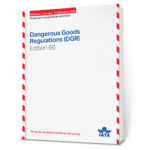
IATA Regulation 2.3: Restrictions on Dangerous Goods
With the holidays approaching, I thought it was an excellent time to remind you or bring to your attention items you cannot take with you, either as carry-on or in your checked luggage.
IATA Regulation 2.3 addresses the restrictions on what can and cannot be transported by air. Here are the key points from this section:
Items Prohibited in Passenger Aircraft
Certain dangerous goods cannot be carried on passenger aircraft under any circumstances, either in carry-on baggage or checked luggage. These include:
- Explosives: Including fireworks, blasting caps, and ammunition. Even small quantities like firecrackers or toy cap guns are strictly forbidden.
- Flammable Liquids: Substances like gasoline, acetone, and paints, which are highly volatile, are prohibited.
- Corrosives: Acids or alkalis, such as sulfuric acid or liquid bleach, that can damage or destroy materials.
- Radioactive Materials: Certain radioactive substances that pose health risks cannot be transported unless special arrangements are made for their containment and transport (usually only in special cargo).
- Toxic Substances: Materials like cyanides or other poisonous chemicals that can harm people upon exposure are prohibited.
These items are too dangerous to be safely transported on commercial passenger aircraft or require special handling and packaging that isn’t feasible on regular passenger flights.
Items That Can Be Transported with Restrictions
While many dangerous goods are prohibited, some can be transported under specific conditions, such as:
- Flammable Liquids in Limited Quantities: Small substances like rubbing alcohol or perfume (under 100ml) can be carried in your carry-on luggage following IATA’s 3-1-1 rule for liquids.
- Lithium Batteries: These batteries, used in laptops, smartphones, and other devices, are subject to strict guidelines due to their risk of overheating or catching fire. Lithium-ion batteries (up to 300 watt-hours) are allowed in carry-on baggage, but larger or spare lithium batteries must be packed in checked baggage under specific conditions.
- Compressed Gases: Items like aerosol cans, butane, or gas cartridges are generally restricted but may be allowed in small amounts (e.g., for personal hygiene items, like deodorant).
- Toxic and Infectious Substances: Some medical and biological items, such as certain vaccines, can be carried under regulated conditions. Passengers traveling with such materials must declare them and ensure proper packaging.
Items for Cargo
Some dangerous goods are only allowed as cargo and are subject to higher scrutiny. These include:
- Large Quantities of Flammable Liquids: For example, fuel or solvents exceeding the allowed limits for carry-on or checked baggage.
- Explosives or Ammunition: Typically transported only on freight aircraft, under controlled conditions, and with the appropriate hazardous materials certifications.
Airlines and freight operators have specific requirements for the packaging, labeling, and documenting of dangerous goods. Usually, passengers cannot transport these items directly but must ship them through special cargo arrangements. If you need to send something restricted, contact a company specializing in those services. ICC may be able to assist with the names of companies that offer this service.
Summary:
Here’s a simplified breakdown of what you can and cannot bring on an airplane according to IATA’s Dangerous Goods Regulations (2.3):
Allowed (with Restrictions):
- Flammable liquids (small quantities) (e.g., perfume, rubbing alcohol)
- Lithium batteries or items with lithium batteries – and only in carry-on, never in checked baggage
- Compressed gases (e.g., small aerosol cans)
- Certain medical supplies (e.g., vaccines, insulin)
Not Allowed:
- Explosives (e.g., fireworks, ammunition)
- Corrosive substances (e.g., acids, bleach)
- Toxic chemicals (e.g., poisons, cyanides)
- Radioactive materials
- Large quantities of hazardous substances (e.g., fuel, solvents)
IATA’s Dangerous Goods Regulations protect the safety of all passengers and crew members during air travel. Understanding and complying with these rules ensures you’re not carrying dangerous goods that could pose a risk. Always check your items before packing and consult your airline if you have any doubts about whether something is classified as dangerous.
When in doubt, it’s better to err on the side of caution. Safe travels! ✈️
Do you have questions about shipping dangerous goods by air? Our team of experts is just a call away for our customers at 855.734.5469 or send us an email, we’re happy to help.
Stay up to date and sign up for our newsletter!
We have all the products, services and training you need to ensure your staff is properly trained and informed.
 IATA DGR |
 Shipping DG by Air Shipping DG by AirTraining |
 4GV Securepacc Complete 4GV Securepacc CompleteShipping Kit |






 ICC USA
ICC USA ICC Canada
ICC Canada